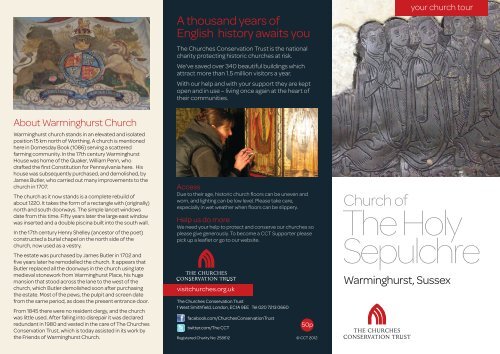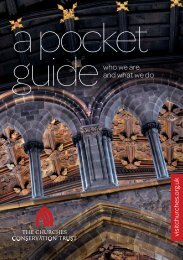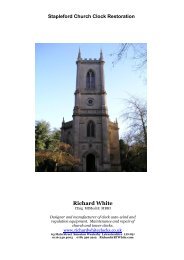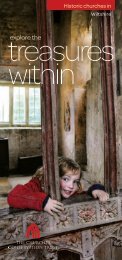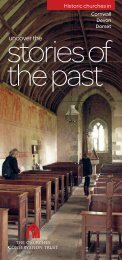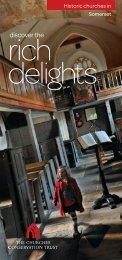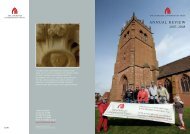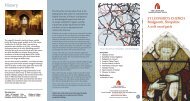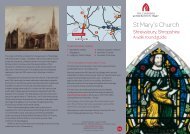Church of The Holy Sepulchre, Warminghurst, West Sussex
Church of The Holy Sepulchre, Warminghurst, West Sussex
Church of The Holy Sepulchre, Warminghurst, West Sussex
You also want an ePaper? Increase the reach of your titles
YUMPU automatically turns print PDFs into web optimized ePapers that Google loves.
About <strong>Warminghurst</strong> <strong>Church</strong><br />
<strong>Warminghurst</strong> church stands in an elevated and isolated<br />
position 15 km north <strong>of</strong> Worthing. A church is mentioned<br />
here in Domesday Book (1086) serving a scattered<br />
farming community. In the 17th century <strong>Warminghurst</strong><br />
House was home <strong>of</strong> the Quaker, William Penn, who<br />
drafted the first Constitution for Pennsylvania here. His<br />
house was subsequently purchased, and demolished, by<br />
James Butler, who carried out many improvements to the<br />
church in 1707.<br />
<strong>The</strong> church as it now stands is a complete rebuild <strong>of</strong><br />
about 1220. It takes the form <strong>of</strong> a rectangle with (originally)<br />
north and south doorways. <strong>The</strong> simple lancet windows<br />
date from this time. Fifty years later the large east window<br />
was inserted and a double piscina built into the south wall.<br />
In the 17th century Henry Shelley (ancestor <strong>of</strong> the poet)<br />
constructed a burial chapel on the north side <strong>of</strong> the<br />
church, now used as a vestry.<br />
<strong>The</strong> estate was purchased by James Butler in 1702 and<br />
five years later he remodelled the church. It appears that<br />
Butler replaced all the doorways in the church using late<br />
medieval stonework from <strong>Warminghurst</strong> Place, his huge<br />
mansion that stood across the lane to the west <strong>of</strong> the<br />
church, which Butler demolished soon after purchasing<br />
the estate. Most <strong>of</strong> the pews, the pulpit and screen date<br />
from the same period, as does the present entrance door.<br />
From 1845 there were no resident clergy, and the church<br />
was little used. After falling into disrepair it was declared<br />
redundant in 1980 and vested in the care <strong>of</strong> <strong>The</strong> <strong>Church</strong>es<br />
Conservation Trust, which is today assisted in its work by<br />
the Friends <strong>of</strong> <strong>Warminghurst</strong> <strong>Church</strong>.<br />
A thousand years <strong>of</strong><br />
English history awaits you<br />
<strong>The</strong> <strong>Church</strong>es Conservation Trust is the national<br />
charity protecting historic churches at risk.<br />
We’ve saved over 340 beautiful buildings which<br />
attract more than 1.5 million visitors a year.<br />
With our help and with your support they are kept<br />
open and in use – living once again at the heart <strong>of</strong><br />
their communities.<br />
Access<br />
Due to their age, historic church floors can be uneven and<br />
worn, and lighting can be low level. Please take care,<br />
especially in wet weather when floors can be slippery.<br />
Help us do more<br />
We need your help to protect and conserve our churches so<br />
please give generously. To become a CCT Supporter please<br />
pick up a leaflet or go to our website.<br />
visitchurches.org.uk<br />
<strong>The</strong> <strong>Church</strong>es Conservation Trust<br />
1 <strong>West</strong> Smithfield, London, EC1A 9EE Tel 020 7213 0660<br />
facebook.com/<strong>Church</strong>esConservationTrust<br />
twitter.com/<strong>The</strong> CCT<br />
50p<br />
Registered Charity No: 258612 © CCT 2012<br />
your church tour<br />
<strong>Church</strong> <strong>of</strong><br />
<strong>The</strong><strong>Holy</strong><br />
<strong>Sepulchre</strong><br />
<strong>Warminghurst</strong>, <strong>Sussex</strong>
1 Three 18th-century hatchments on the nave north wall<br />
7 Set into the north wall <strong>of</strong> the chancel is the most<br />
9 Below the Elizabeth Benet monument may be seen<br />
were carried at funerals <strong>of</strong> members <strong>of</strong> the Butler family,<br />
important monument in the church (cover). This inset<br />
two narrow rectangular recesses. <strong>The</strong>se form the<br />
who owned the estate from 1702 to 1805.<br />
brass commemorates Edward Shelley (d. 1554), his wife<br />
base <strong>of</strong> a double piscina – a 13th-century feature that<br />
2 A large marble monument<br />
commemorates John<br />
Riches, a London<br />
merchant, who was<br />
Trustee <strong>of</strong> James Butler<br />
and lived at <strong>Warminghurst</strong>.<br />
and children. It is particularly interesting for two reasons.<br />
First, the (now lost) central depiction above the figures<br />
was <strong>of</strong> <strong>The</strong> <strong>Holy</strong> Trinity and was one <strong>of</strong> the last<br />
constructed in England as the policy <strong>of</strong> Elizabeth I<br />
(who came to the throne in 1558) was very much<br />
against such representations. Second, the children<br />
along the base are identified by the first letter <strong>of</strong> their<br />
comprised two drains<br />
for the washing <strong>of</strong> the<br />
priest’s fingers and the<br />
chalice during the<br />
medieval mass. <strong>The</strong>y<br />
may have been filled in<br />
when the monument<br />
11<br />
8<br />
3 <strong>The</strong> pine box pews date<br />
from the 18th century.<br />
Of varying sizes, they were<br />
rented to reflect the social<br />
status <strong>of</strong> their occupants.<br />
Those nearest the screen<br />
have drawers to contain<br />
the prayer-books. <strong>The</strong> plain benches, without doors,<br />
Christian names. <strong>The</strong> boy on the left, Edward Shelley<br />
Junior, has had his head cut<br />
<strong>of</strong>f very cleanly and<br />
deliberately. This would have<br />
been done after he brought<br />
disgrace on the family by<br />
Vestry<br />
being executed in 1588 for<br />
harbouring a Catholic priest.<br />
10<br />
above was erected.<br />
To the left <strong>of</strong> the pulpit<br />
is a memorial tablet to<br />
George Freeman<br />
(d. 1938) who founded<br />
<strong>The</strong> Times Educational<br />
Supplement.<br />
were free and were for those unable to<br />
11 <strong>The</strong> three-decker pulpit <strong>of</strong> pine and<br />
afford the pews.<br />
oak is well lit by the lancet window in<br />
4<br />
the south wall. <strong>The</strong> Clerk’s desk has a<br />
delightful book rest and a gargantuan<br />
1<br />
2 5<br />
7<br />
chair <strong>of</strong> elm. From here the parish<br />
3<br />
clerk led the service.<br />
12<br />
5<br />
6<br />
<strong>The</strong> chancel and nave are divided by an<br />
18th-century pine screen <strong>of</strong> three<br />
arches, topped by the Royal Arms <strong>of</strong><br />
Queen Anne, painted on plaster after<br />
1707 when England and Scotland were<br />
joined by the Act <strong>of</strong> Union. <strong>The</strong>y were<br />
repainted in 1845 by E Martin, who signed<br />
his work in the bottom right-hand corner.<br />
<strong>The</strong> doorway into the burial chapel <strong>of</strong><br />
Henry Shelley is <strong>of</strong> considerable interest.<br />
Although placed here in the early 17th<br />
century the stonework is at least one<br />
hundred years older. <strong>The</strong> sides and step<br />
<strong>of</strong> the doorway show signs <strong>of</strong> excessive<br />
wear, suggesting that it started<br />
life as a main thoroughfare in<br />
<strong>Warminghurst</strong> Place before<br />
being moved here as part <strong>of</strong><br />
Butler’s remodelling <strong>of</strong> the<br />
church in 1707 when the big<br />
house was demolished.<br />
<strong>The</strong> altar rails are an especially<br />
good example <strong>of</strong> late 17thcentury<br />
work with turned<br />
wooden balusters.<br />
5<br />
13<br />
14 11<br />
8<br />
12<br />
South<br />
Vestry<br />
Nave 4<br />
6 Chancel<br />
N<br />
On the south wall <strong>of</strong> the chancel is a large marble<br />
monument to Dame Elizabeth Benet who died in 1721.<br />
She was married to the James Butler who remodelled<br />
the church in 1707. <strong>The</strong> monument is signed at the base<br />
<strong>of</strong> the left-hand column ‘Stanton & Horsn London’.<br />
Edward Stanton and Christopher Horsenaile are<br />
considered the most important sculptors <strong>of</strong> their period.<br />
10<br />
9<br />
13<br />
14<br />
8<br />
<strong>The</strong> font dates from the<br />
1707 rebuilding. Above it is<br />
an iron crane to support<br />
an elaborate cover.<br />
Behind the font is a fine<br />
16th-century iron chest.<br />
<strong>The</strong> south vestry was originally built<br />
as a porch, but was converted into a<br />
schoolroom by the construction <strong>of</strong> a<br />
high brick floor in the 19th century.<br />
However, its doorway is 13th century<br />
and original to the church. On the<br />
left-hand side (viewed from inside<br />
the vestry) is the remains <strong>of</strong> a<br />
medieval mass dial (a sundial to tell<br />
the times <strong>of</strong> service when this was an<br />
outside door) and on the right the<br />
remains <strong>of</strong> a holy water stoup<br />
(to contain water blessed for<br />
personal devotion).<br />
13


